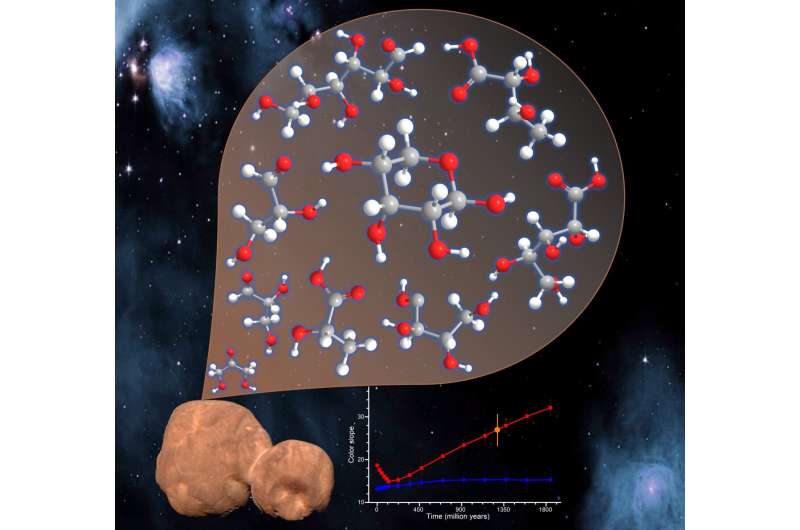June 4, 2024 report
This article has been reviewed according to Science X's editorial process and policies. Editors have highlighted the following attributes while ensuring the content's credibility:
fact-checked
peer-reviewed publication
trusted source
proofread
Simulation of factors that led to Arrokoth's red color suggest its surface is rich in sugars

A team of space scientists and chemists at the University of Hawaii at Mānoa, Université Côte d'Azur and the Southwest Research Institute has found the planetesimal Arrokoth likely gets its red color from a surface rich in sugars.
In their study, published in the Proceedings of the National Academy of Sciences, the group attempted to simulate how exposure to cosmic rays could have affected the planetesimal.
In 2019, NASA's New Horizons spacecraft passed by Arrokoth, a planetoid in the Kuiper Belt, which circles the sun beyond the orbit of Neptune. Researchers on the project discovered that the surface of the planetoid was pinkish red, but scientists were not able to explain why. In this new effort, the research team simulated the planetoid on a computer and exposed it to the conditions it has likely endured over the past 1.8 billion years.
Prior research has suggested that Arrokoth was formed by the collision of two smaller objects. Additional data from New Horizons showed its surface is covered in frozen methanol. The simulations involved firing electrons (proxies for galactic cosmic rays) at samples of frozen methanol.
By speeding up the simulations, the researchers were able to show what occurred over 1.8 billion years. They then studied the results using a variety of spectroscopic techniques.
They found that such a bombardment could result in the formation of several sugar-type compounds, which, when viewed from space, would appear as pinkish or red, depending on the angle of sunlight reflection.
The team found that by adjusting the degree of bombardment by the electrons, they could fine tune the coloration until they found a close match with Arrokoth.
The research team also noted that some of the sugars that developed were similar in nature to those found in RNA here on Earth, suggesting the possibility of life getting its start due to comets that underwent similar transformations prior to striking the planet billions of years ago.
More information: Chaojiang Zhang et al, Ionizing radiation exposure on Arrokoth shapes a sugar world, Proceedings of the National Academy of Sciences (2024). DOI: 10.1073/pnas.2320215121
Journal information: Proceedings of the National Academy of Sciences
© 2024 Science X Network



















